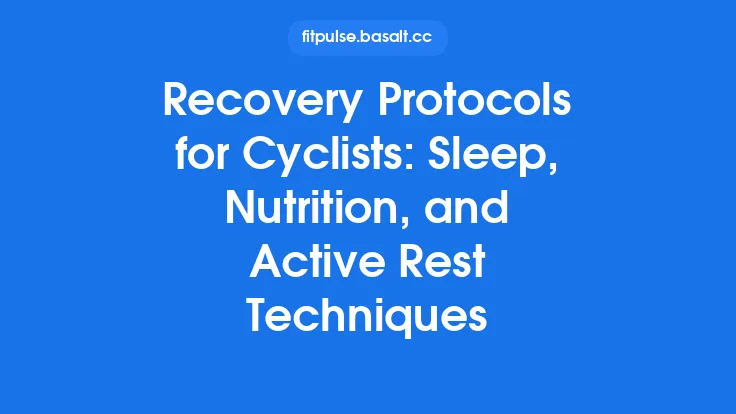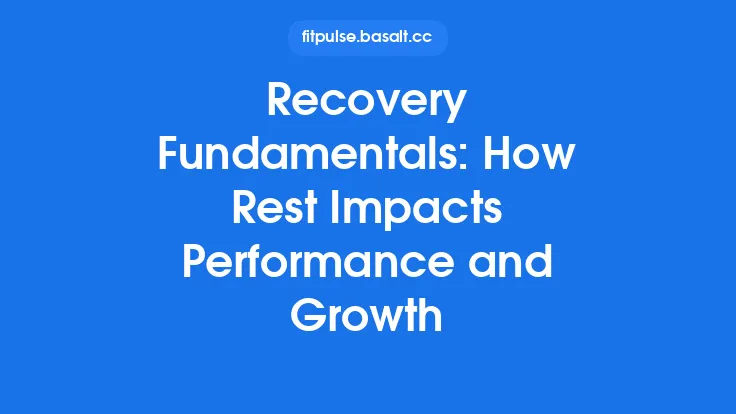Sleep is the single most powerful, yet often overlooked, tool in an athlete’s recovery arsenal. Modern sleep‑tracking technology has turned what was once a vague, subjective feeling into a quantifiable, actionable dataset. By continuously monitoring the duration, continuity, and quality of nightly rest, these systems provide insights that allow athletes, coaches, and fitness enthusiasts to fine‑tune recovery protocols, reduce injury risk, and ultimately boost performance on the field, track, or gym floor.
Why Sleep Is Central to Recovery
During sleep the body undergoes a cascade of physiological processes that repair muscle tissue, replenish energy stores, and regulate hormonal balance. Growth hormone, for instance, peaks during deep phases of sleep, stimulating protein synthesis and tissue regeneration. Likewise, cortisol—a catabolic hormone—drops to its lowest levels, allowing anabolic processes to dominate. Even without delving into the minutiae of sleep stages, the overarching principle remains clear: the longer and more uninterrupted the sleep period, the more opportunity the body has to execute these restorative functions.
When sleep is insufficient or fragmented, the recovery window narrows. Muscle soreness lingers, glycogen repletion stalls, and the nervous system remains in a heightened state of arousal. Over time, this can translate into diminished power output, slower sprint times, and a higher likelihood of overuse injuries. Sleep‑tracking technology makes it possible to detect these patterns early, before they manifest as performance setbacks.
Core Sleep Metrics Captured by Modern Devices
Most consumer‑grade and professional sleep trackers focus on a handful of core variables that together paint a comprehensive picture of nightly rest:
| Metric | What It Represents | Why It Matters for Recovery |
|---|---|---|
| Total Sleep Time (TST) | The cumulative minutes spent asleep per night. | Directly correlates with the amount of time the body has to perform restorative processes. |
| Sleep Efficiency | Ratio of time asleep to time spent in bed (percentage). | High efficiency indicates minimal wakefulness, reducing interruptions to recovery cycles. |
| Sleep Latency | Time taken to transition from full wakefulness to sleep. | Prolonged latency can signal elevated stress or poor sleep hygiene, limiting total restorative time. |
| Wake After Sleep Onset (WASO) | Total minutes awake after initially falling asleep. | Frequent awakenings fragment sleep, disrupting the continuity needed for optimal recovery. |
| Resting Heart Rate (RHR) Trends | Night‑time heart rate measured during sleep. | A lower RHR often reflects a well‑recovered autonomic nervous system, while elevated RHR can flag lingering fatigue. |
These metrics are derived from a combination of accelerometry (detecting movement), photoplethysmography (measuring blood flow to infer heart rate), and ambient sensors that gauge temperature and light exposure. Advanced algorithms filter out noise, differentiate between light movements and true awakenings, and present the data in an easy‑to‑interpret dashboard.
Translating Sleep Data Into Recovery Strategies
Once the raw numbers are available, the real value emerges when they are integrated into a structured recovery plan. Below are common ways athletes leverage sleep insights:
- Adjusting Training Load
If a series of nights shows a dip in sleep efficiency below a pre‑defined threshold (e.g., 85 %), coaches may reduce volume or intensity for the following session. This prevents cumulative fatigue from snowballing into overtraining.
- Optimizing Nutrition Timing
Knowing that glycogen replenishment is most efficient during the early phases of sleep, athletes can schedule carbohydrate‑rich meals or recovery shakes within the post‑exercise window to align with the upcoming sleep period.
- Fine‑Tuning Pre‑Sleep Routines
Elevated WASO often points to environmental or behavioral factors—excessive screen time, caffeine intake, or a noisy bedroom. By correlating spikes in WASO with daily habits logged in a companion app, users can iteratively refine their bedtime rituals.
- Targeted Recovery Modalities
When RHR trends upward for several consecutive nights, it may indicate incomplete autonomic recovery. In response, athletes might incorporate additional modalities such as contrast showers, gentle yoga, or massage to stimulate parasympathetic activity.
- Periodization Planning
Over a macro‑cycle, sleep data can highlight periods where athletes naturally achieve higher sleep quality (e.g., off‑season). Training plans can be structured to exploit these windows for high‑intensity blocks, while taper phases align with periods of lower sleep quality.
Performance Gains Linked to Optimized Sleep
Empirical research consistently demonstrates a dose‑response relationship between sleep quantity/quality and performance metrics:
- Strength & Power: A 1‑hour increase in nightly sleep has been associated with a 2‑3 % rise in bench‑press repetitions and a measurable boost in vertical jump height.
- Endurance: Athletes who maintain ≥ 8 hours of sleep exhibit improved VO₂max values and faster recovery of lactate thresholds after high‑intensity intervals.
- Cognitive Function: Reaction time, decision‑making speed, and visual tracking—all critical in team sports—show measurable improvements after nights of high sleep efficiency.
By systematically tracking sleep, athletes can identify the personal “sweet spot” where incremental sleep gains translate into tangible performance improvements, rather than relying on generic recommendations.
Practical Implementation for Athletes and Fitness Enthusiasts
- Select a Consistent Wearable
Choose a device that can be worn nightly without discomfort. Consistency in data collection is more important than the brand or price point.
- Set Baseline Benchmarks
Record sleep metrics for at least two weeks under normal training conditions. This baseline will serve as a reference for detecting deviations.
- Define Actionable Thresholds
Establish simple rules—e.g., “If sleep efficiency < 85 % for two consecutive nights, reduce next day’s training volume by 10 %.” Keep thresholds realistic and aligned with individual goals.
- Integrate with Training Logs
Pair sleep data with workout logs, nutrition diaries, and subjective wellness scores. The combined dataset reveals patterns that isolated metrics cannot.
- Review Weekly, Adjust Monthly
Conduct a brief weekly review to spot short‑term trends, and a deeper monthly analysis to refine long‑term strategies. Involve coaches or sports scientists when possible for objective interpretation.
- Prioritize Sleep Hygiene
While not a deep dive into best practices, maintaining a dark, cool sleeping environment and limiting stimulants before bed supports the data captured by the tracker.
Common Pitfalls and How to Avoid Them
- Over‑reacting to Single Night Anomalies
One night of poor sleep is often a statistical outlier. Base adjustments on trends rather than isolated data points.
- Ignoring Individual Variability
Some athletes thrive on 7 hours, others on 9. Use personal baselines rather than population averages to set targets.
- Relying Solely on Device Readouts
Sleep trackers are tools, not replacements for bodily awareness. Combine objective data with how you feel physically and mentally.
- Neglecting External Factors
Travel, altitude changes, and competition schedules can temporarily disrupt sleep patterns. Anticipate these disruptions and plan recovery buffers accordingly.
Leveraging Sleep Tracking for Sustainable Performance
In the modern fitness landscape, data-driven decision making extends far beyond heart rate zones and step counts. Sleep tracking offers a direct line of sight into the body’s most fundamental recovery process. By systematically capturing core sleep metrics, translating them into concrete recovery actions, and aligning training loads with nightly rest quality, athletes can unlock consistent performance gains while minimizing injury risk. The technology serves as a feedback loop: better sleep fuels better training, which in turn supports deeper, more restorative sleep—a virtuous cycle that underpins long‑term athletic success.




